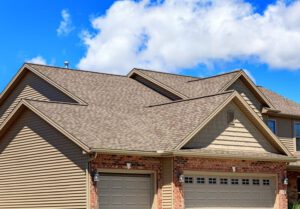Roofing is the top covering of a building and includes all materials and constructions that support it. It is an important feature of a building, as it protects the building from weather elements and acts as part of the building’s envelope. In the States, mansard roofs are common. They are more stable than other types of roofs and can last for 75 years.

The materials used for roofs come in a wide range of types. Some are lightweight, while others are heavy and durable. Concrete, for example, is commonly used for roofing. Another option is fire-retardant wood, which is relatively inexpensive and robust. Steel, on the other hand, is extremely light but is the most expensive option.
Metal roofs are popular in warmer climates, as they reflect heat. They’re usually installed in large panels, making repairs easy. If a panel is damaged, you can patch the hole with a waterproof sealant, so you don’t need to replace the whole panel. Metal roofs are also extremely practical and durable.
Roof decking provides extra support and structure for roofs. Unlike the exterior roofing material, this material is not visible from the inside of a building. It also helps regulate air circulation inside the building. Common types of decking include wood, concrete, steel, and rubber. These materials are used for a variety of roofing applications, including flat roofs.
Roofing materials can range from traditional materials such as clay and slate to new materials. Many homes use asphalt shingles. These materials are inexpensive, durable, and easy to install. But there are many pros and cons to choosing a different material for your home. If you’re considering replacing the roof on your home, consider all the options available to you and weigh the pros and cons of each one.
Another common roofing material is bituminous waterproofing underlayment. These layers of asphalt-impregnated paper and felt protect the roofing material from water damage. Often, roofing systems include multiple layers, including clay tiles, which require an underlayment. The underlayment helps control water drainage and also provides insulation from heat sources.
Clay tiles can offer a unique aesthetic to a construction project. They are also one of the most sustainable roof materials available. They are extracted from clay pits, fired, and glazed to create a long-lasting roof. And they’re 100 percent recyclable, which means you can reuse them for many years.
Wooden roofs are also a popular choice and are traditionally used on ranches and bungalows. Although they can cost a bit more, they are a great option for homes. The most common types of wooden roofing are cedar, redwood, and southern pine. These roofs generally last for about 25 years but can be costly.
Pitched roofs are stronger and more stable in heavy rain than flat roofs. They also offer better drainage. Because the water drains off easily, it doesn’t build up and create structural pressure. The steeper angles on a pitched roof also guide rain and snow away from the building, minimizing the risk of water damage. This means that a home built with a pitched roof is more weather resistant and less expensive to repair.
Pitched roofs are characterized by one rafter with an inclination of at least 45 degrees. They’re the most inexpensive to build and the simplest to install. Builders often try to make the incline higher than 45 degrees to provide better drainage. Common structures with this type of roof include lean-tos and sheds. They’re also commonly used on cabins in the mountains.
Pitched roofs also require less maintenance than flat roofs. A pitched roof will not need to be repaired as frequently and can be maintained for over 100 years. Another benefit is that they’re environmentally friendly. Natural slate is one of the most durable roofing materials, lasting for hundreds of years.
A pitched roof is more stable than a flat roof during heavy rain because it provides better drainage. When rain falls on a flat roof, the water can build up and cause structural pressure. A single-pitched roof is also known as a shed or pent roof. It has one slope and is attached to a taller wall. This type of roof also offers additional storage space.
Pitched roofs are also better for regulating the temperature of a building. Pitched roofs have more space for natural ventilation between the flat interior and outer roof. This helps maintain the temperature of the interior space while eliminating damp air from the roof during winter and letting hot air escape during the summer. Flat roofs require special materials and techniques to keep them waterproof. A pitched roof is generally used in commercial buildings.